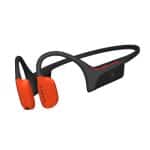
Suunto Wing 2 review: Open-ear sound with a few clever extras
Suunto Wing 2
Pros
- Secure fit for running & cycling
- LED safety lights improve night visibility
- Long battery life with the power-bank case
- Useful head-gesture and button controls
- Dual-mic wind filtering
Cons
- Sound lacks bass and depth
- Wraparound design may clash with helmets or long hair
- Requires the app for full feature access
Suunto Wing 2 review: One minute review
The Wing 2 is built for people who train outside and want to stay aware of what’s going on around them. It’s not about perfect sound or flashy design. It’s about being able to run, ride or move without blocking your ears or fussing with gear. The fit is mostly solid, the sound is good enough for what it is, and the battery life doesn’t get in the way.
You’re paying a bit more than you would for other open-ear options, but you’re also getting features like safety lights, head gestures, voice feedback from Suunto watches, and a tough build that handles sweat and bad weather. If those things matter to you, it makes sense. If not, there are cheaper choices that still get the basics right.
This isn’t a headset you wear around the house. It’s something you grab for training and leave on without thinking. If that’s what you’re after, the Wing 2 delivers.
You can check them out on Suunto’s website. They typically retail at $179. You can also find them on Amazon (check price).
Suunto Wing 2 review: Look and feel
The Wing 2 has that familiar wraparound style you’d expect from open-ear sports headphones. It loops behind your head and hooks over your ears, with a frame that’s flexible enough to handle rough use but still feels sturdy. Once it’s on, it stays put. I’ve worn it through runs and other workouts without needing to adjust it.
Build-wise, it’s mostly soft silicone with a bit of structure underneath to keep its shape. It’s super light coming in at just 35 grams, and while the design is pretty plain, it doesn’t look or feel cheap. The matte finish helps with grip when you’re sweaty, and there’s nothing glossy or flashy to get in the way. It looks like it’s made for training, not attention.
The audio mostly delivers. You get clear sound without shutting out the world. That’s the whole point of open-ear. You’ll still hear traffic, people, whatever’s around. The bone conduction bit can feel odd at first, but it works well once you’re used to it and helps keep things safer when you’re out moving.
A nice touch is the set of LED lights. You don’t see them when you’re wearing the headphones, but they’re there. You can keep them steady, set them to blink, or have them pulse in time with your steps. It’s a simple way to boost visibility when it’s dark out.
Built into the frame are two discreet physical buttons, and another button is tucked onto one of the buds. More on those in a bit.
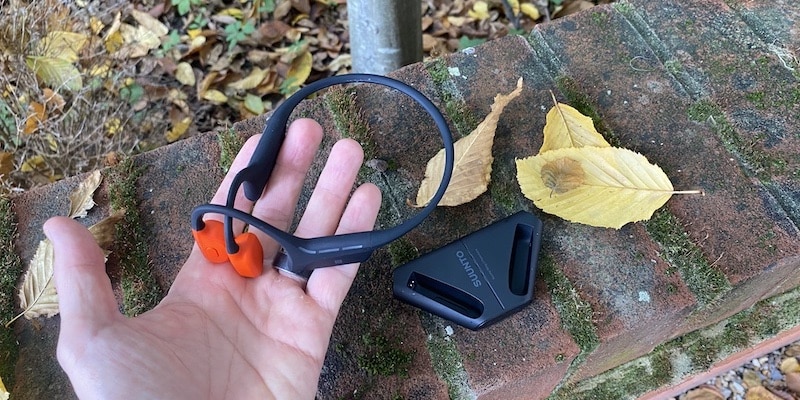
The design uses a one-size-fits-all band that hangs fairly low at the back. At first, I wasn’t sure if that would throw things off, but the fit turned out fine. It lines up properly around my ears and the audio is not affected. Nothing looks off or feels awkward once they are on.
Having said that, if you wear a helmet, cap or hydration pack, the back of the band can press against things or feel a bit off. It’s not uncomfortable, but it can be noticeable depending on what you’re wearing or doing.
Suunto Wing 2 review: Battery life
Battery life isn’t something you’ll need to stress about. You get up to 12 hours from the headset, which is plenty for a few workouts or even a full day if you’re using it on and off. If you keep the LED lights or gesture controls active the whole time, it’ll drain quicker, but not drastically.
The case gives you another 24 hours or so. For most people, that means you can go nearly a week of daily runs or commutes without needing to reach for a charger.
The charging itself is pretty simple. The headset clips into the case using a magnetic dock, and the whole thing charges via USB-C. The headphones cross over neatly when docked, and a small clip holds them in place. Looks tidy and keeps them secure while charging.
A full refill takes about an hour for the headphones. The case takes a bit longer. You get status lights on the case to check battery levels, and the headphones themselves show how much juice is left too. Handy before heading out the door.
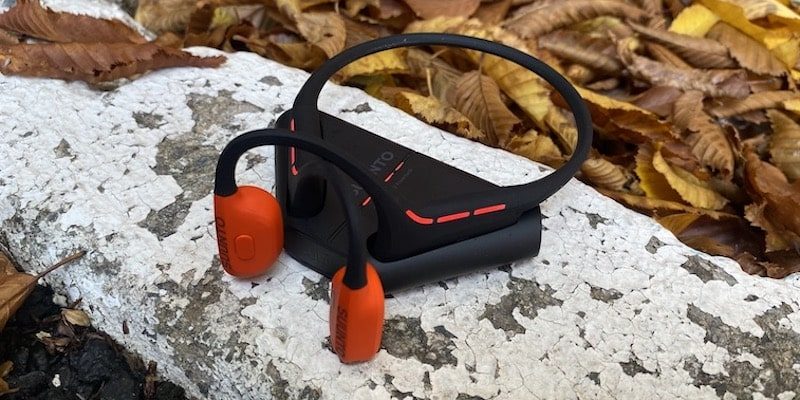
Most days I just rest the headset in the case after a run and that’s it. It charges itself, and I only need to plug the case in now and then. Super simple. There’s a soft pouch too if you want to take all of this gear with you.
Suunto Wing 2 vs 1: Tech specs comparison
The Suunto Wing 2 smooths out some rough edges from the original. The most obvious changes are in build and usability. It’s a touch heavier, but still comfortable, and the slightly refined frame feels sturdier around the ears. The LED lights now have smarter modes that can sync with your cadence or act as turn indicators, which makes them more practical for night runs or cycling.
Bluetooth has been bumped to version 5.3, which improves stability, and the new sensors track neck movement and posture in addition to handling head gestures. Battery life is another small step forward, offering an extra 2 hours.
As far as sound, the maximum volume has been bumped up by 5 dB. Suunto has tweaked the internal metal parts and onboard EQ to give the sound a bit more punch. Still, it’s an open-ear design, so the usual trade-offs remain. You will not get in-ear headphone quality. But for outdoor use and sports, that balance between awareness and audio quality works well.
Spec | Wing 2 | Wing 1 |
|---|---|---|
Release date | September 2025 | October 2023 |
Weight | 35 g | 33 g |
Dimensions (headphones) | 103 × 126 × 47.6 mm | 102.5 × 126.5 × 46.5 mm |
Materials | Silicone + Titanium Alloy | Silicone + Titanium Alloy |
Water / dust resistance | IP66 | IP67 |
Battery life (headphones) | Up to 12 hours | up to 10 hrs |
Battery life with powerbank | up to 24 hrs | up to 20 hrs |
Charge time (headphones) | ≤1 h | ≤1 h |
Charge time (headphones) | ≤1.5 h | ≤1.5 h |
Bluetooth range | >10m | >10m |
Bluetooth version | 5.3 | 5.2 |
Supported wind noise filter | up to ~30 km/h | up to ~30 km/h |
Extra features | Enhanced motion sensors, LED safety lights with cadence and turn modes, integration with watch ecosystem | Open-ear bone-conduction, LED lights, head-motion control |
Colour options | Orange, Black | Lime, Lava Red, Black |
Price | $179 | $169 |
Suunto Wing 2 review: Functionality
Getting started with the Suunto Wing 2 is pretty straightforward, though there’s a bit of a learning curve until you figure out all the controls. Start off by holding the power button for a few seconds to switch it on.
The headset connects via Bluetooth to your phone or a Suunto watch. Once paired, it’ll reconnect automatically each time you turn it on. You can use it for music, calls or get voice feedback during workouts if you’re using a supported Suunto model. I paired it with my Vertical 2 watch.
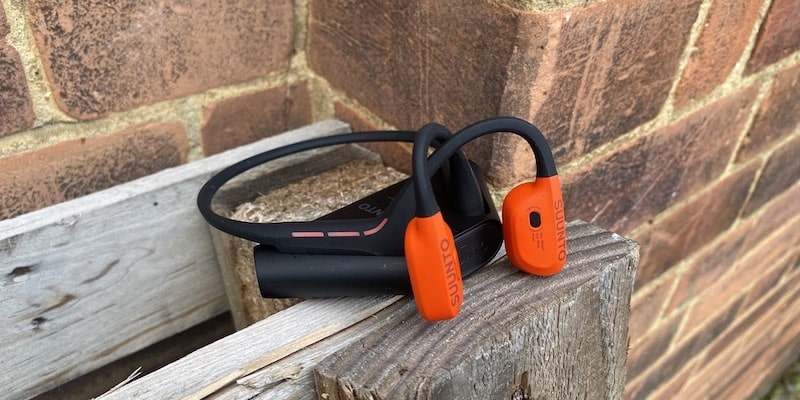
As far as controls, there’s a multifunction button on one of the buds, plus a volume up and power button (“+”) and a volume down button (“-”) on the frame. The multifunction button handles things like play and pause, skipping tracks, going back, answering or ending calls and more. You can also use the “-” button to control the LED lights.
Now you don’t need the app to use the headphones, but if you do install it, there’s quite a bit of extra functionality. It allows you to pair to more than one Bluetooth device, choose between sound modes, customise the buttons and customise the LED behaviour.
The app also lets you enable head gestures. A nod skips a track, a shake goes back or rejects a call. It works well once calibrated, but if you’re moving your head around during a paused session, it might kick in by mistake.
The app is simple, and your settings get saved directly to the headset. So once you’ve set it up, you don’t need to mess with it again.
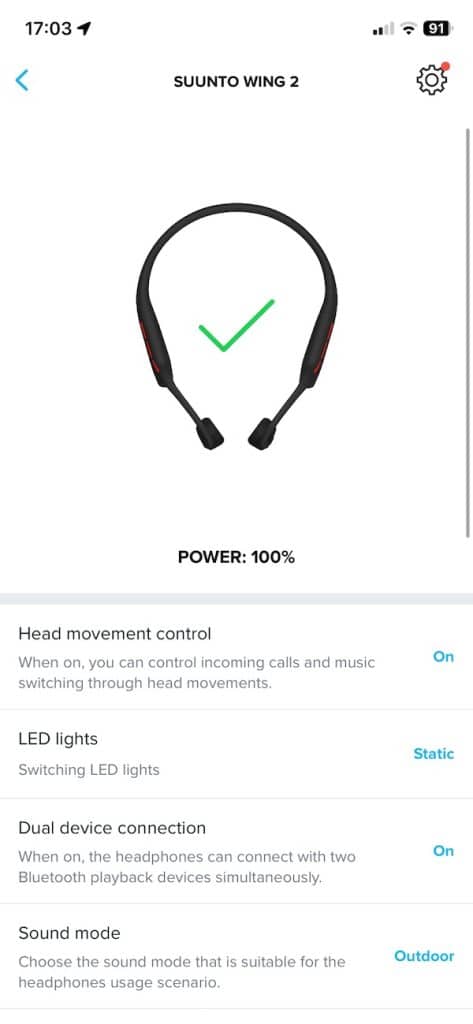

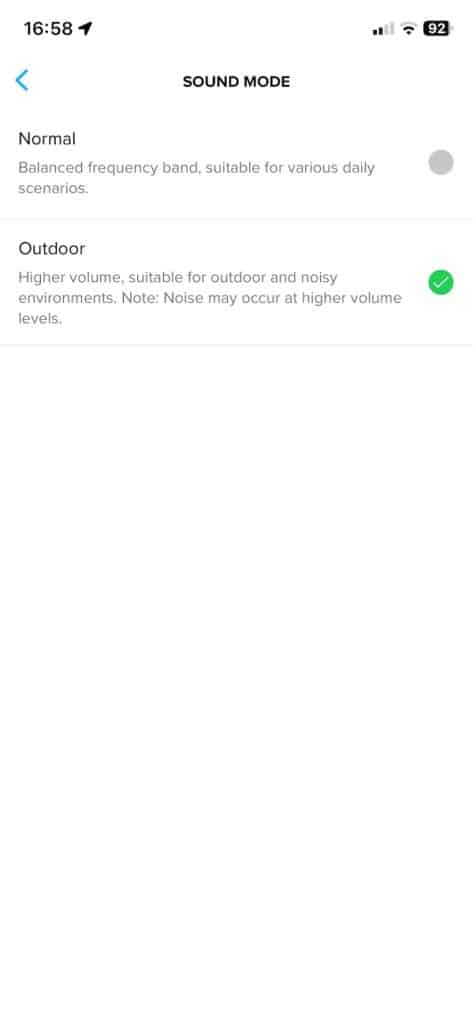
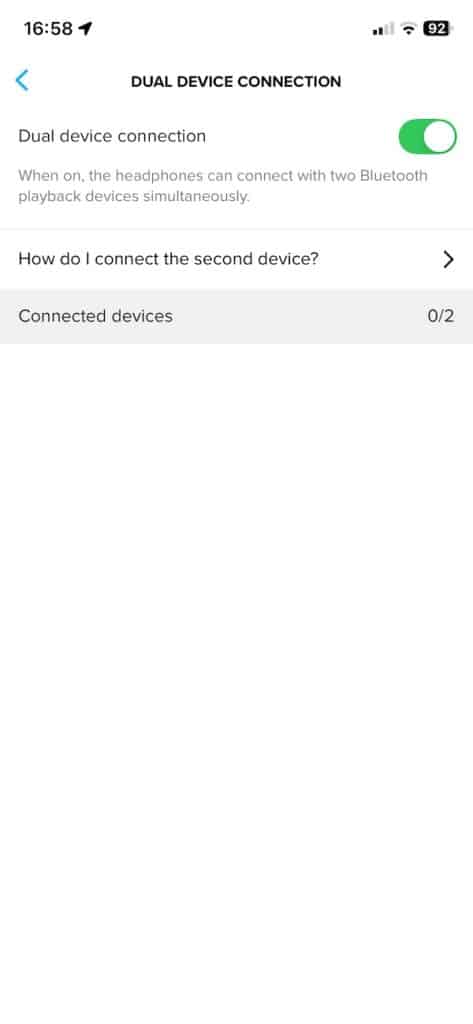
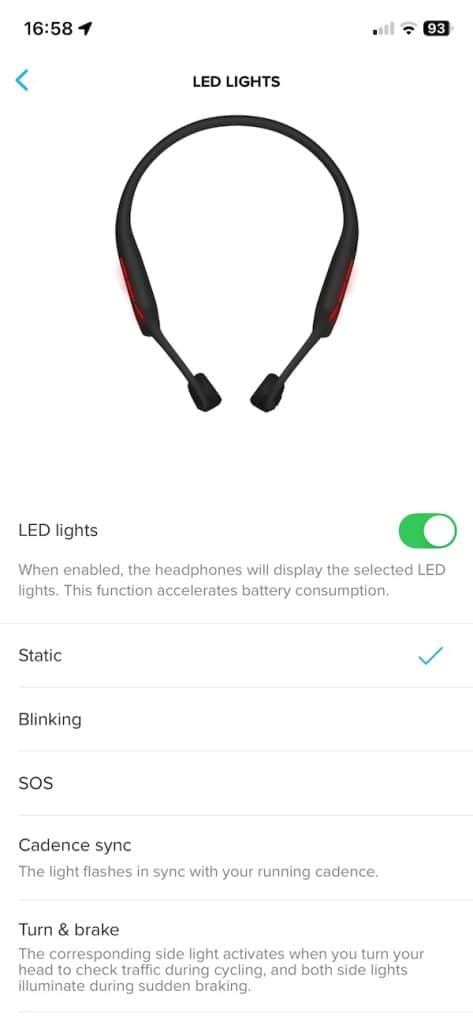

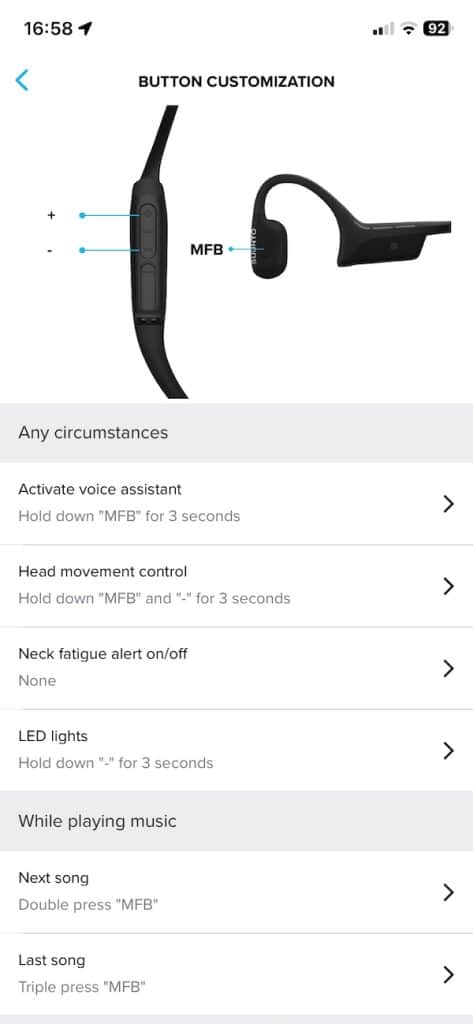
Getting audio feedback during workouts, takes a bit of effort initially. Install the Suunto Wing 2 app on your watch, turn on the headphones, and pair them through the SuuntoPlus menu before starting an activity. Then enable Voice Feedback and choose what updates you want to hear. Just make sure the headphones are connected to the watch, not your phone, so the voice prompts come through clearly.
The Wing 2 can connect to two devices at the same time, but how well that works depends a bit on what you’re pairing it with. I’ve had a few moments where a music app didn’t pick up the headset right away, but reconnecting always fixed it.
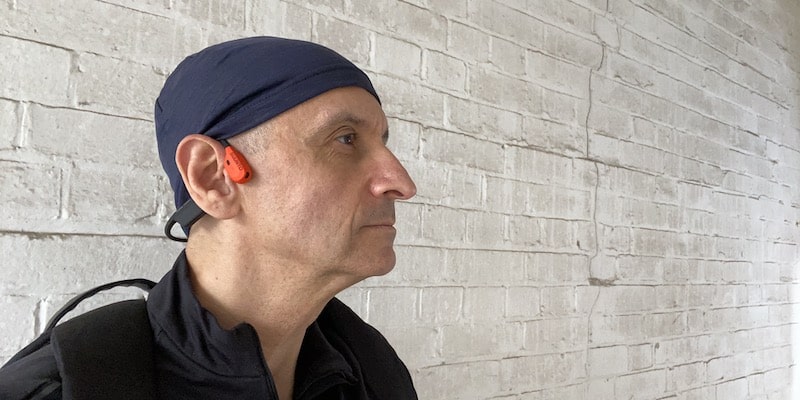
Physical assessments
A nice touch are various physical assessments that can be done with these headphones. This includes neck mobility and jumping assessments.
The first of these gives an assessment of your cervical spine flexibility or, put more simply, how stiff your neck is. As directed by the test, you just move your head side to side, up and down while wearing the headset – and it tracks how far you can go in each direction.
I gave it a go and it pointed out some tight spots and a bit of imbalance. Nothing major, but enough to show I’ve got some work to do. The app shows you the results and then gives you a few stretches to help fix things. If you sit at a desk all day or spend hours staring at screens, this is worth doing.



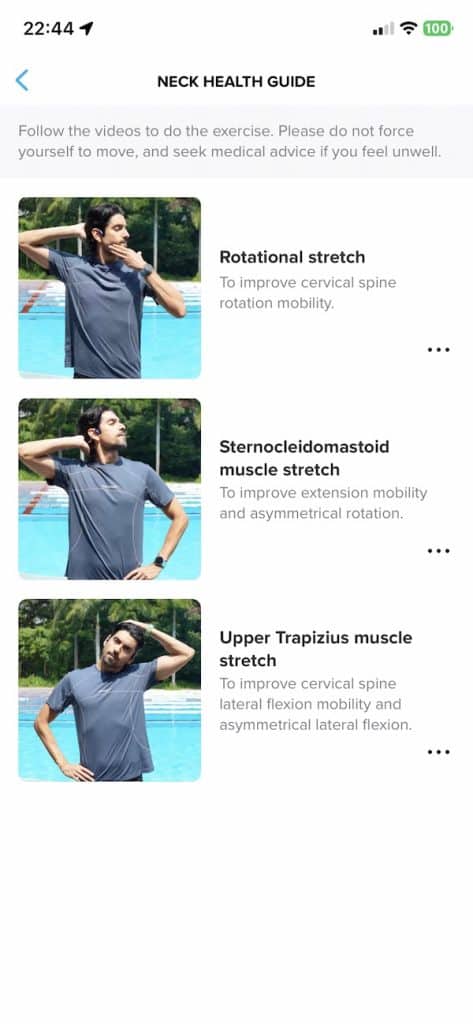
The other test is also useful. You do three quick jumps with your hands on your hips, and the app measures your jump height each time. It then calculates your average height, flight time, and takeoff speed to give you a baseline. This baseline helps track neuromuscular fatigue over time.
You’re meant to do the test before and after training to see how your numbers shift. If one of your jumps seems off, you can re-do it before saving the final result. Once saved, the system uses this to track how fresh or tired your legs are on future workouts.

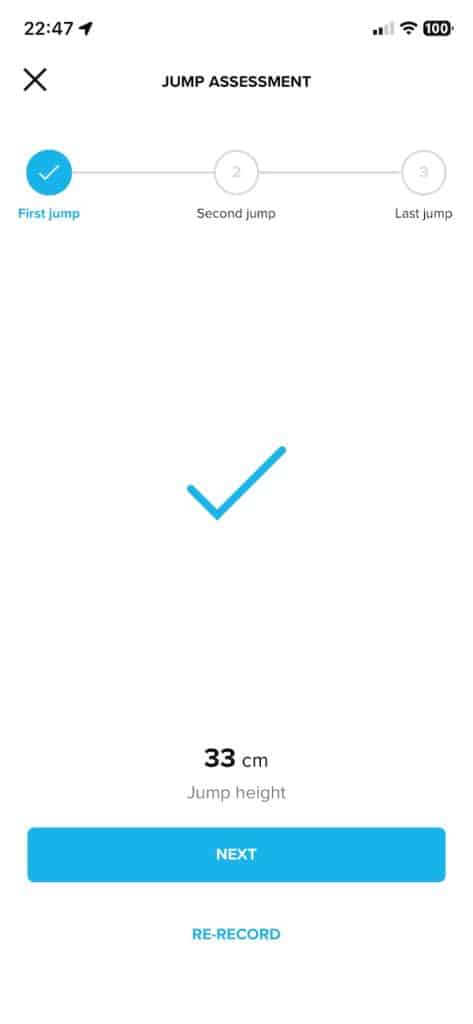
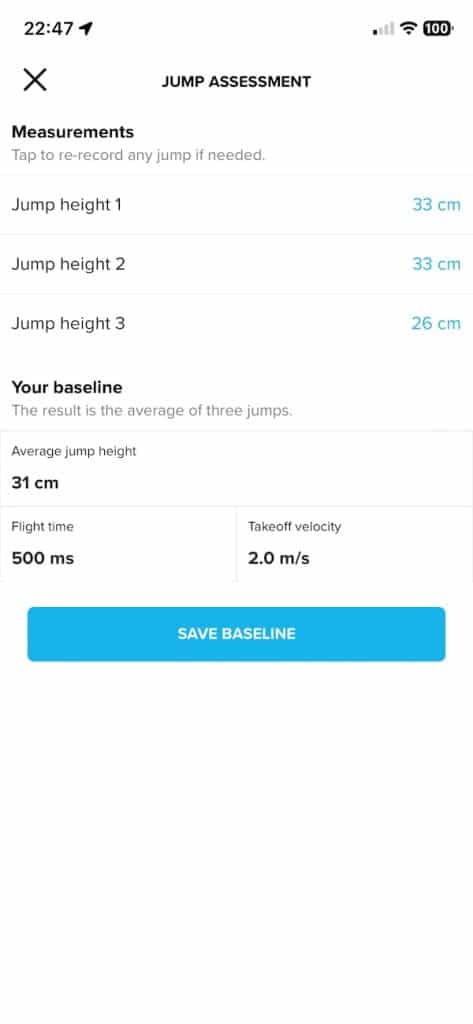
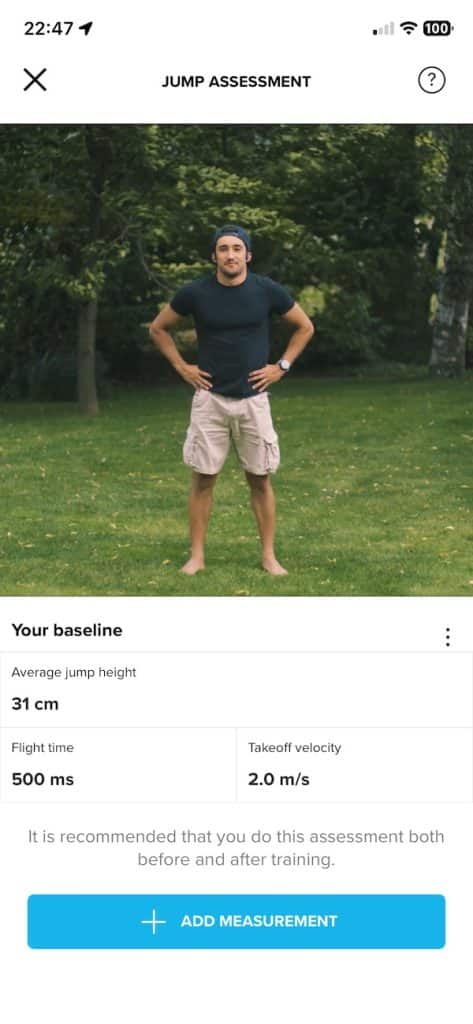
There’s also a neck fatigue alert you can turn on if you want. It gives you a nudge to move your neck when you’ve been still for too long, which helps avoid stiffness or strain. It’s mainly useful if you wear the headphones while cycling or sitting in one position for long stretches.
Suunto Wing 2 review: Sound quality
Finally, we get to the all-important sound quality. On Wing 2 it is pretty decent for an open-ear headset. Volume goes up high enough, and I can still hear what’s going on around me. Bass has a bit more punch than your average bone conduction set, mids are fine, and vocals come through clearly. It won’t compete with in-ear buds, so if that’s what you’re after, this isn’t it. But for something that keeps your ears open, it holds up just fine.
Out running or on the bike, Wing 2 does a good job. I usually keep the volume around two-thirds and that’s plenty to hear music or a podcast while still being aware of traffic or people nearby. Push it too loud and you’ll start to feel the vibration on your face, but that’s normal with this kind of headset.
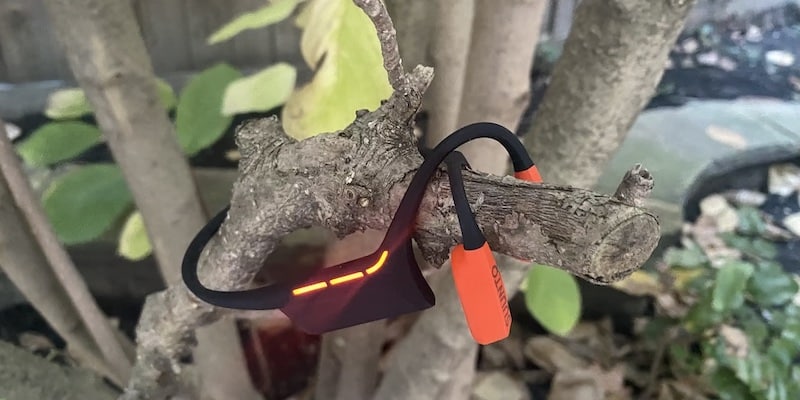
Call quality is also solid enough. The dual mics on the right side of the headphones cut through wind better than expected. I tried them on a blustery run and didn’t have any complaints from the other side. You won’t get super crisp audio, but for quick chats without pulling your phone out, it does the job.
Worth noting is that if the headset isn’t sitting snug against your head, you’ll notice a big drop in volume and clarity. Bone conduction doesn’t work well through air, so that contact really matters. But when it’s fitted right, it’s great for staying aware and still getting your music or podcast fix.
You can Wing 2 on Suunto’s website. They typically retail at $179. You can also find them on Amazon (check price).
Buy if
- you train outdoors and want to keep your ears open to surroundings
- you want voice feedback from your Suunto watch during workouts
- you value built‑in safety lights for early morning or evening runs
- you want headphones with a secure fit and rugged build
- you’re okay with paying a bit more for extra features
Don’t buy if
- you care most about deep bass and immersive sound and don’t need open‑ear awareness
- you wear a helmet or have a hairstyle or head size that might make the rear band uncomfortable
- you don’t use a Suunto watch and won’t benefit from the extra feedback features
- you want premium audio for movies, gaming or studio use rather than workouts and outdoor use
*We are a review site that receives a small commission from sales of certain items, but the price is the same for you. Purchasing items by clicking on links in this article allows us to run this website. We are independently owned and all opinions expressed here are our own. See our affiliate disclosure page for more details.
Subscribe to our monthly newsletter! Check out our YouTube channel.
And of course, you can follow Gadgets & Wearables on Google News and add us as a preferred source to get our expert news, reviews, and opinion in your feeds.

